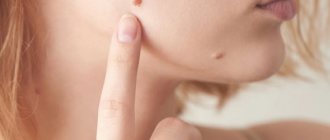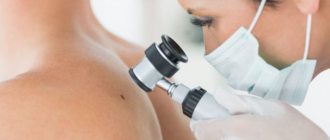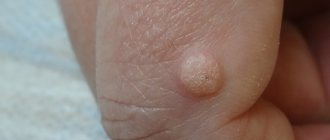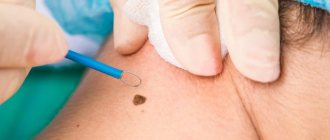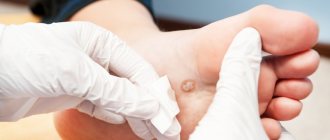External beauty and attractiveness in modern life are becoming not only desirable, but also a necessary attribute of creating a positive image. Fashion is changeable, and piquant spots and warts on the face and body, so popular in past centuries, are now perceived as a significant drawback that spoils one’s appearance. Moreover, they are not as harmless as they seem at first glance.
A wart, scientifically called a papilloma, does not appear on the body just like that. In ancient times, the cause of the appearance of papillomas was considered to be the evil eye, frogs, and much more. But only now, with the advent of modern molecular diagnostic methods, has it become clear: the cause of papillomas is the human papillomavirus (HPV).
Today, more than 100 types of HPV are known.
It is reliably known that HPV type 2 primarily affects the skin, causing the appearance of warts, and HPV 6, 11, 16, 18, 30, 31, 33, etc. gravitate to the mucous membranes. The human papillomavirus has long been considered the cause of only skin and genital warts, and only relatively recently have the oncogenic properties of papillomaviruses been discovered - their ability to cause cancer and, first of all, cancer of the genital organs in both men and women.
Based on long-term research, doctors have created a classification of HPV according to its oncogenic activity:
- “High-risk” HPV types (primarily 16, 18, 31 and 45). Increase the risk of precancerous diseases and genital cancer.
- “Low risk” HPV types (mainly 6 and 11). They cause the appearance of condylomas, but are not associated with precancerous diseases and cancer of the genital organs.
The presence of “high-risk” HPV in the body increases the likelihood of developing cancer by 60 times.
How does the virus manifest itself?
An important circumstance is that clinical manifestations of HPV are not detected for quite a long time. Focusing on a long asymptomatic period, one should not underestimate the danger of human papillomavirus infection. Already today in the United States, infection caused by HPV is the most common viral disease, predominantly sexually transmitted (in our country, large-scale studies in this direction have not yet been conducted). Plus, HPV damage to the cervix, even in the presence of clinical manifestations, often goes undetected for a long time.
Infection with the human papillomavirus usually occurs through close contact with the source of infection. HPV can be transmitted with scales peeled off with papillomas during sexual play with hands, during sexual intercourse, and when women use hygienic tampons, it can be carried from the external genitalia into the vagina, onto the cervix. Infection of newborns during childbirth is possible.
Each wart, papilloma or condyloma (these are just different names for the same disease, differing only in the place of manifestation of the tumors) is a reservoir for the human papillomavirus. This virus also accumulates in the tissues surrounding the tumor, which can cause changes in the DNA of epithelial cells of the skin or mucous membranes of the genital organs, resulting in the development of precancerous conditions.
Papillomas manifest themselves as papillary growths protruding above the surface of the skin or mucous membrane, most often have a thin stalk, and sometimes a wide base. They can take on bizarre shapes that look like hairs, cauliflower or a cockscomb.
Dangerous sun.
For each person, the critical duration of exposure to sunlight is highly individual. It’s not easy to determine this line, so it’s better to just remember that prolonged exposure to the sun is harmful to the body. The skin is forced to protect itself from ultraviolet radiation. Excessive tanning means inevitable burns. If you love beach holidays so much that you simply cannot deny yourself this pleasure, at least listen to the following tips. By following these simple recommendations, you will not only improve your health, but also reduce the risk of a dangerous disease.
- Staying in the sun is safe from morning until 10 o'clock, in the evening after 17 o'clock.
- For people with a large number of moles, it is better to reduce their exposure to the sun.
- Try to avoid redness and sunburn on your skin. If this happens, spend 2-3 days in the shade.
- After swimming in the sea, be sure to rinse your skin with fresh water.
- Even young and healthy people can spend no more than one and a half to two hours a day in the sun.
- Taking certain medications increases the skin's sensitivity to light. Please consult your GP before going on holiday.
- Use sunscreen cosmetics: at the beginning of the holiday, the indicator should be maximum, about 40 units.
- Do not use decorative cosmetics, deodorants and perfumes on the beach - they can cause the appearance of age spots on the skin.
Types of papillomas
Depending on the location, the following types of external manifestations of HPV are distinguished:
- Vulgar (simple) warts
, which account for up to 70% of all skin warts and are more common in school-age children. They are elevations above the surface of the skin with an uneven, keratinized surface. They most often appear on the hands, but can be on the edges of the lips, on the face and, extremely rarely, on the oral mucosa. - Flat (juvenile) warts
are less common (4%). They are found in children and young people on the back of the hands and feet, face, and oral mucosa. These are warts of different shapes; they have a smooth surface and slightly rise above the skin level. - Palmoplantar warts
are very common (34% of cutaneous warts). They are dense formations with horny layers. - Filiform warts
are soft, flesh-colored to dark brown papillomas, often pedunculated. They are located on the neck, skin of the eyelids, armpits, groin, under the mammary glands. - Genital condylomas
are multiple, less often single, soft papillomas located on the mucous membranes of the genital organs, around and inside the rectum, sometimes in the urethra. They have the appearance of simple (pyramid, ball) or complex (cauliflower) growths with a keratinizing surface on the stalk.
Is it possible to remove a wart with iodine?
This drug can and should be used for almost any type of wart. It is suitable for eliminating:
- flat warts located on the face;
- papillomas in the genital area;
- chicken;
- threadlike.
The result of cauterization with iodine will be noticeable after just a few days of use.
Each person’s body is individual, so for some, warts may disappear immediately, and for some, this remedy will not be suitable or effective at all.
Self-medication is harmful
Do not try to diagnose and treat HPV infection on your own! Firstly, there is a risk of improper use of drugs. Secondly, only a doctor can distinguish papilloma from a malignant tumor. In addition, self-treatment is fraught with consequences.
Today, there are celandine-based preparations on sale that are intended to eliminate warts. Celandine juice is similar in composition to iodine. Therefore, prolonged exposure to the drug causes skin burns. In this case, papillomas are seriously injured and can provoke the development of skin cancer. Cauterization with iodine is even more dangerous - it is more aggressive than celandine. Trying hard to get rid of papillomas with iodine, you can get scars on the skin. Vinegar is no better in this regard. Attempts to bandage warts and papillomas with a thin silk thread often only provoke the growth of these formations.
If you suspect the appearance of warts or genital warts, you should definitely seek advice from a dermatologist, urologist or gynecologist, depending on the location of the source of infection. Only a professional can correctly diagnose the disease and prescribe the necessary treatment.
Iodine for warts: features, properties and effectiveness
People who have growths on the skin are wondering how to get rid of a wart once and for all. Many would like to do this without going to the clinic. Skin lesions can be treated with something as simple as iodine. This is a very effective method for eliminating growths without consequences or relapses. It is especially recommended to use iodine if the warts are located:
- on the limbs;
- on the armpits;
- in the genital area;
- on the neck.
The treatment does not leave scars, and the effect of complete removal of warts is achieved after a month of use.
Having an antiseptic effect, iodine not only helps to heal wounds and scratches, but, in high concentrations, removes condylomas and papillomas.
The drug consists of only 5% iodine, the rest of the contents of the vial are alcohol. But even this content is enough to affect the neoplasm tissue, which subsequently completely destroys the papilloma virus.
The product is cheap, available at any pharmacy and available without a prescription.
Removal of papillomas
The question of the need to remove papillomas is decided unequivocally - it must be removed. No wonder, literally translated from some languages, a wart is “excess meat.” In addition, damage to papillomas, when they reach large sizes or are injured by linen and clothing, leads to the formation of long-healing, easily bleeding wounds into which infection can penetrate.
Removal can be done using various methods: traditional surgery, chemical cauterization, thermal or cryodestruction. The most modern and safe types of surgery are radio wave and laser.
The impact on surrounding healthy tissue is minimized. When removing warts and papillomas using these methods, the formation of scars or scars in their place is almost completely eliminated. Healing of the skin after removal occurs within several days. In parallel with the removal, antiviral therapy is necessarily carried out.
Unattended moles.
Some types of moles can degenerate into one of the most malignant tumors - melanoma (skin cancer). The initial site of formation of most melanomas is congenital pigment spots and warty moles. How does this dangerous development begin?
For example, after damage, a person only notices how the color of the mole begins to change, it enlarges, cracks, turns into an ulcer, and sometimes into a tumor. Therefore, without panicking, pay attention to the above symptoms, especially the progressive enlargement of the mole and change in its color. If all these symptoms occur, immediately rush to the dermatologist. The unfavorable prognosis of melanoma dictates the need for regular monitoring by a doctor. In addition to irritant factors (ultraviolet radiation, trauma), the development of melanoma can also be caused by genetic and endocrine factors. However, in the first place is, of course, excessive exposure to the sun. Ultraviolet radiation in large doses causes irreversible changes in skin cells, greatly increasing the risk of their degeneration. Light-skinned and fair-haired, red-haired people with blue and gray eyes are most susceptible to the mutagenic effects of sunlight. Those at risk also include those who have a lot of freckles, age spots and moles.
Strengthening the immune system
Modern medicine has not yet learned to kill viruses. But an important fact is that HPV carriage is not lifelong. In addition, medicine has a small number of means at its disposal that allow it to remove some of the viruses from the body. The use of these drugs is fully compatible with immunomodulatory therapy.
The amount of virus in the body is directly related to the state of the body’s immunity - the better the immunity, the less virus. Therefore, the most promising way to reduce the concentration of HPV in the body is to strengthen the immune system. For this purpose, a separate course of treatment is carried out, after which the person begins to feel much better.
Finally, there are very effective preparations for topical use - creams, gels, sprays that increase local immunity and reduce the concentration of the virus in the affected tissues.
Disadvantages of iodine treatment
Cauterizing warts with iodine can have negative aspects. These include:
- Formation of burns with frequent and strong use of the product.
- May burn strongly when applied.
- It accumulates in the human body, namely in the thyroid gland, which can subsequently negatively affect health. Hyperthyroidism sometimes develops due to excess iodine.
- The appearance of relapses on the fingers and other parts of the body. The case is rare, but possible.
- If the growth is on rough skin (on the legs and feet), it is difficult to achieve an effect with such treatment. This is especially true for plantar warts.
- When removing warts with iodine, unsightly brown spots remain on the face, neck and other open areas of the body.
Bibliography:
1) Cockayne S, Hewitt C, Hicks K, Jayakody S, Kang'ombe AR, Stamuli E, Turner G, Thomas K, Curran M, Denby G, Hashmi F, McIntosh C, McLarnon N, Torgerson D, Watt I; EVerT Team. Cryotherapy versus salicylic acid for the treatment of plantar warts (verrucae): a randomized controlled trial. BMJ. 2011 Jun 7; 342:d3271. doi: 10.1136/bmj.d3271.
2) Dall'oglio F, D'Amico V, Nasca MR, Micali G. Treatment of cutaneous warts: an evidence-based review. Am J Clin Dermatol. 2012 Apr 1; 13(2): 73-96. doi: 10.2165/11594610-000000000-00000.
3) Nguyen NV, Burkhart CG. Cryosurgical treatment of warts: dimethyl ether and propane versus liquid nitrogen – case report and review of the literature. J Drugs Dermatol. Oct 2011; 10(10): 1174-6.
4) Ahn CS, Huang WW. Imiquimod in the treatment of cutaneous warts: an evidence-based review. Am J Clin Dermatol. 2014 Oct; 15(5): 387-99. doi:10.1007/s40257-014-0093-5.
Contraindications for the procedure
Before applying iodine for the first time, you must make sure that there is no allergic reaction. In some cases, iodine solution causes severe allergies. If you have an individual intolerance, you cannot use the remedy; it is better to replace it with a pharmaceutical drug. Iodine and vinegar are not suitable for treating tumors in children under 16 years of age. For young men, other recipes from traditional healers should be used. For example, walnut peel has a similar effect. It is necessary to rub the damaged area with the skin for two weeks.
If there are wounds, scratches or other damage to the papilloma, treatment of warts with iodine should be postponed until healing. Otherwise, the medicine will penetrate too deeply and cause burns. It is better to refuse the procedure for pregnant and lactating women or if the skin is prone to acne and diathesis.

